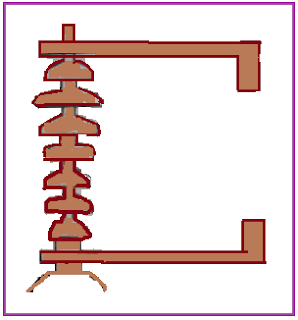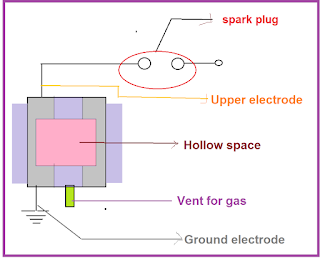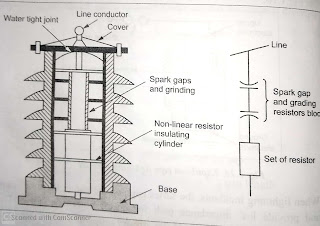Are you interested in learning about lightning arrestor? If so, you will definitely get some more information.
By reading this article, you will get an answers to the following
- What is the use of lightning arrestor?
- History of the lightning arrester
- What is the requirement of a lightning arrester?
- What is the type of lightning arresters used in modern days at substations?
- What is the structure of different lightning arresters? etc.,
What is the use of Lightning Arrester?
A lightning arresters are devices that protects the high voltage equipments such as transmission lines, transformers, circuit breakers from sudden lightning or transient voltage events by diverting the surge to the ground.
As an electrical site engineer, you should always know the IEC standard for Lightning Arrester is 62305. This standard specifies the requirements for the design, testing and installation of lightning arrestors. It is important for engineer to know the standard to ensure that LA are installed and operated correctly.
Transient voltage-sudden voltage rise due to lightning
History of the lightning arrester
Although Benjamin Franklin invented the lightning rod in 1750, it did not play a crucial role in protection until 1890s.
Tell me and I forget teach me and I remember, involve me and I learn Benjamin Franklin
During the time of 1892-1908, high voltage equipment on substations was protected by using the air-gap lightning arrester. These arrester conducted high voltage lightning to the ground. This method is also also known as Line-to-ground method.
In the period 1908 to 1930, technology improved and non-linear resistor lighting came into the field. These arrestors works by puncturing and reforming films of silicon carbide or other materials.
Oxide film arresters were introduced in the market from 1920 to 1930. The oxide film is a thin film designed to breakdown when high voltage surge enters, allowing the surge to pass through the arrester. and to the ground.
In the 1970s, Silicon non-linear resistors and silicon carbide non-linear valves were developed. These arresters uses silicon carbide elements which provides low resistance to high voltage surge. The element breakdown, allowing the surge to pass through the arrester and to the ground.
Zinc Oxide arrester types were used after 1970's because these are most effective in protecting equipment's. These uses lower clamping voltage, which mean that they can protect electrical equipment from lower voltage surges.
Lightning arrester in substation
The best place for installing a lightning arrester is at the entry point and exit point of the substation to protect the electrical equipment from lightning and all line towers must provide a lightning arrester for discharging abnormal voltage and current to the ground.
The basic requirement of a lightning arrester
- Lightning arresters should discharge lightning voltage to the earth before reaching the electrical equipment.
- Lightning arrester should have high resistance for normal voltage, and high conductivity for high voltage.
- Lightning arresters should discharge the current without damaging itself.
- It is the Protective device used to protect the electrical equipment against lightning.
Types of Lightning arrestor
In a substation, three types of lightning arrestor system is installed
- Rod Gap Lightning Arrestor
- Valve-type Lightning Arrestor
- Expulsion type Lightning arrestor
Rod gap Lightning arrester
Rod gap lightning arrester consists of the rod on both ends. Whenever the main protective lightning arrester fails to operate, then the rod gap lightning arrester will protect the system.
Rod gap lightning arrester is considered the secondary type of protective system. So, a rod gap lightning arrester can be used as backup protection.
Rod gap lightning arrester Construction.
A square rod, cut at right angles for a particular distance. That distance is called the rod gap.
Working Principle of Rod Gap Lightning Arrestor
The main function of this rod gap is to divert the surge. Whenever the magnitude of an incoming wave exceeds the gap setting of the rod gap, a spark over occurs, and the spark or surge is diverted.
Advantages
- The structure is simple.
- Low cost.
- construction is strong.
Disadvantage
- Power frequency supply follows the current after spark over.
- Each operation of rod gap results in L-G and the breaker operation is required to isolate the faulty area.
- Overheat is produced during operation.
Expulsion Type Lightning Arrester
Expulsion type lightning arrester is also known as Protector tube, this type of lightning arrester consists series of spark gaps. The devices consist of an Upper electrode, Hollow space, Fibre tube, Ground electrode, Hollow space(gap).
Structure Of Expulsion Type Lightning Arrester
Working principle of expulsion type LA
- Fiber tubes act as an arc quenching medium. ie, Whenever the overvoltage occurs arc is extinguishes with the help of a fiber tube.
- When lightning occurs, the series gap and the gap in the hollow space Provide a low impedance path for current to flow.
- After spark over occurs the voltage across the terminals of the Lightning, arrester becomes low.
- Now arrester exerts an opposition to the flow of the following current.
- The Fibre tube quenches the arc which is stuck in the tube.
- Quenched gas exit out through the vent
Advantage expulsion type LA
- Low cost
- It protects low voltage transformers such as distribution transformers, station service transformers.
Disadvantage expulsion type LA
- It is not suitable for the protection of expensive stations and high voltage rated equipment
Valve-type Lightning Arrester.
A valve type of lightning arrester is used to protect the substations, line termination, and electrical equipment.
This device discharges overvoltage (due to lightning) into the earth or earth grid. It is also called the Non-linear type.
Structure and function of Valve type Lightning arrester.
- Valve type lightning arrester consists of Non-Linear resistor elements made up of silicon carbide arc arranged one over other into numerous sections.
- A set of Non-Linear resistors are separated by spark gaps.
- Watertight housing is provided to protect spark gaps and resistors.
- It provides a low resistance path to high current and high resistance to low current.
- Whenever a high voltage flow through the line due to lightning then non-linear resistance becomes high conductive material and discharges the voltage into the earth.
Advantage of valve type lightning arrester
- The valve-type lightning arrester is used to protect the electrical equipment above rated voltage 400kv and above.
- This type of lightning arrester is capable to protect motors and generators.
- This type of lightning arrester is used to protect the station service transformer.
The disadvantage of valve type arrester
- The cost is too high.
- Without periodic maintenance, it cannot be operated.





Thanks for Sharing...!
ReplyDeleteChemical Earthing Electrode
Earthing Electrode
Thank you for sharing such a informative article about lighting arrester, Lighting arrester is the protective device for surge voltage and lighting. Now-a-days its gaining much importance for commercial as well as domestic purposes. For checking more information and types of arrester you can check out or visit Axis-india
ReplyDelete
ReplyDeleteMRS Agencies is a Best Chemical Earthing/ Gel Earthing Electrode Manufacturers in India. We manufacturer earthing electrode with high quality raw material with long life of earthing electrode products, our production team boost earthing electrode with latest technology. We also Provide Pure Copper Earthing Electrode, Copper Bonded Chemical Earthing Electrode, Chemical Pipe Earthing Electrode in world wide at best price.
Very Great Post. I Have Really Enjoyed Your Posts Because It Is Very Informative . After All I’ll Be Subscribing On Your Feed And I Am Hoping You Write Again Very Soon.and If You Need More Information About That You Can Check Out My page Also
ReplyDeleteVery Great Post. It's Really Very Informative . After All I’ll Be Subscribing On Your Feed And I Am Hoping You Write Again Very Soon.and If You Need More Information About That You Can Check Out My Page Also
ReplyDeleteVery Great Post. It's Really Very Informative . After All I’ll Be Subscribing On Your Feed And I Am Hoping You Write Again Very Soon.and If You Need More Information About That You Can Check Out My Page Also
ReplyDeleteVery Great Post. It's Really Very Informative . After All I’ll Be Subscribing On Your Feed And I Am Hoping You Write Again Very Soon.and If You Need More Information About That You Can Check Out My Page Also
ReplyDeleteAbsolutely love your blog, so informative and engaging! By the way, have you considered the added protection Copper Lightning Arresters can offer?
ReplyDeleteWow, I came to learn about machines, and your information is absolutely amazing! For more insights and if your are looking for the Lightning protection system
ReplyDelete! Ensure your safety with GSC Earthing - Lightning strike counter Manufacturers. Protect your devices from electromagnetic signals with our Lightning event recorder technology.!